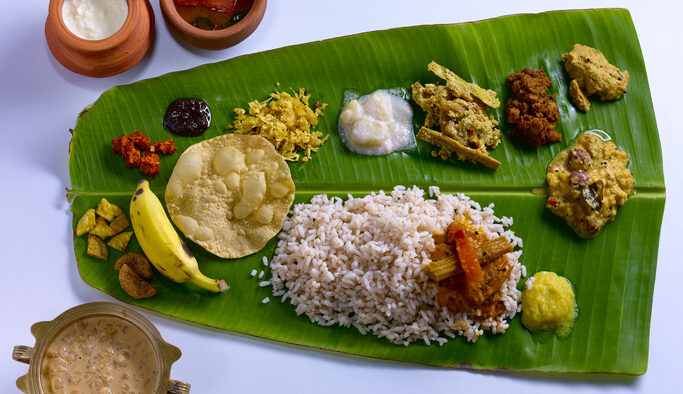Onam Sadhya has simple food, still sumptuous, and the dishes served have minimal spice, and are easy to make preparations without too much of process involved
Kerala celebrates return of Mahabali as Onam. The generous king, who as per the legend offered his head in addition to the sky and earth to Lord Vishnu, and in return he was allowed to visit his land, and people once every year. A very important part of the celebrations is the Onam Sadhya – the nine-course meal, which is predominantly vegetarian.

Those, who have had the good fortune of tasting the traditional Onam Sadhya will vouch for the soulful, simple, definitely delicious and healthy spread. Sadhya is an elaborate meal made with seasonally available vegetables predominantly using coconut in its grated version or the milk as base or for oil form for the flavour. The quintessentially Kerala dishes including thoran (dry vegetable dish that uses a hearty portion of grated coconut), mezhurkupuratti (stir fries) kaalan and Olan, which are liquidy in consistency using yoghurt and coconut milk respectively are must have dishes on Onam Sadhya.
There is no concept of eating curd as much in this part of the world. Instead Pulisheri is popular – the turmeric mixed butter milk-based preparation that resembles a kadhi. Erisheri made using combination of vegetables like Yam and Pumpkin is a wet curry and uses bean paste for flavour. Also served on the banana leaf of the Sadhya are pickles, payasam, banana chips – both the savoury and sweet versions, and the Kerala Matta rice to go with the side dishes.
Traditionalists maintain that in olden days Onam Sadhya meant nine dishes, and the leaf started to fill up in years to come by adding a few dishes, and by adapting a few more dishes from within the cuisine, like sambar imported from Tamil Nadu. And some opine that some traditional dishes too are vanishing like the Puzhukku – a semi - dry preparation made using yam or even tapioca. While a few dishes vanish few more make their way – like the many variety of payasams – pazham, palada, kadala, parippu that made their way in the place one payasam that’s served towards the end.

Onam Sadhya from the land of Kerala, which is also the land of Ayurveda may be elaborate, but the dishes are simple preparations made using minimal oil and spice. They are healthy and even the serving pattern if followed while eating is said to aid in digestion. The absence of onion (shallots are used in a few dishes) and garlic steers the menu towards sattvic. However, as Seetha Anand Vaidyam, shares, as it is celebrated across religions with a Pookolam (flower decoration on the floor) and the feast; over the years onion and garlic have made their way into the dishes.
Seetha Anand, Founder, Ananda, Foundation for Holistic and Healthy Learning and Living and author of ‘Good’ Food, a Guide to Healthy Cooking and Eating' was born in Kerala, and loves the cuisine that she says follows the traditional principles of healthy eating. Her annual Onam Sadhya get togethers are the most sought after by friends and family.
“If Onam Sadhya is cooked in the traditional way, it is one of the healthiest feasts made using local seasonal vegetables. In the contrary to most feasts in our country that are usually associated with a lot of deep fries, Onam Sadhya uses very little oil.
Kerala has retained the practice of topping up the dishes with oil towards the end and not from the beginning. It is naturally healthier to not heat the oil more. And, cold pressed coconut oil is always used for the purpose, which has the rare and extremely good Lauric Acid in it, and is considered the good fat.”
It is believed that King Mahabali, who is celebrated on Onam, was a vegetarian, and hence Onam Sadhya is a vegetarian feast.
Very simple food, still sumptuous, the dishes on Onam Sadhya have minimal spice, and are easy to make preparations without too much of process involved.

Seetha Anand elaborates, "Take for example Olan. There is a popular saying in Kerala that translates to - Why have 100 dishes, when you can have just one – Olan. Such is the love for this dish made by cooking sliced white pumpkin and cow pea beans on steam, adding coconut milk, salt and sliced chilli, cooked some more before topping it with coconut oil.
Another popular dish Manga Chamandi is made by making a paste of raw coconut, raw mango, chillies and salt.
Unlike the Avial that’s found in restaurants now a days, traditionally Avial does not use carrots and drumsticks. It is made using locally grown seasonal vegetables like ash gourd, the fresh chickpea bean (lobia), yam, air potatoes, raw banana – it is basically a mixed vegetable stew made using ground coconut with chillies added to cooked vegetables, and topped with whisked sour curd and salt. This is cooked just enough to bring it to a light boil, curry leaves are added and the dish is finished with a spoonful of coconut oil.
Be it the payasams or the stir fries made using boiled vegetables – traditionally the dishes are simple and healthy. The only deep-fried things that you find on the Sadhya spead are the banana jaggery chips and Pappadam.”
Kaanam Vittum Onam Unnanam – One can even sell their property to eat Onam Sadhya is a popular proverb, and why not, especially in today’s age and day when the more extravagant the celebrations are, the more expansive Onam Sadhya is. What continues to be a tradition is the simplicity and healthy aspect of the vegetarian dishes on the menu.





